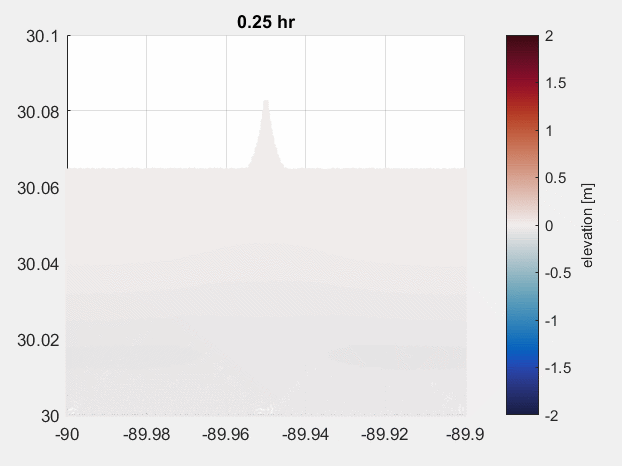Idealized Channel Problem
This example tests ADCIRC version 55 (and beyond). It tests the simulation of a diurnal tide on a sloping beach with a channel along its centerline (adapted from [1]). It tests lateral periodic boundary conditions and the absorption-generation sponge layer [2] [3]. The test finishes in about 8 minutes in parallel ADCIRC (2 processors) for 6 hours of simulation. Note that the short 6 hour length of the test is chosen only to limit simulation time for the GitHub test suite where the test case been found. Users may extend the simulation length to simulate more of the inundating phase of the incoming wave.
Mesh
The mesh is comprised of 64,415 vertices and 127,784 triangular elements, with resolution in the 10-60 m range. The mesh is symmetrical in the east-west direction so that the east and west lateral boundary vertices match for the application of the periodic lateral boundary conditions. An elevation specified boundary condition and absorption-generation sponge layer is prescribed at the southern end of the domain.

Left: Mesh triangulation and resolution. Blue line shows the elevation specified boundary condition location, green and yellow lines on the sides show the periodic lateral boundary condition locations. Center: Mesh topo-bathy. Right: The sponge strength coefficients.

Elevation time series for the idealized channel problem |

North-south velocity time series for the idealized channel problem |
Options/Features Tested
IM = 111112: Uses the explicit scheme (computational time step is 2 seconds).
A00, B00, C00 = 0.0, 1.0, 0.0: Must be used with explicit scheme.
NOUTGE = 5: Outputs the global elevations into a netCDF4 fort.63 file.
NOUTGV = 5: Outputs the global velocities into a netCDF4 fort.64 file.
NOUTGW = 5: Outputs the global meteorology into a netCDF4 fort.73 file (pressure) and a netCDF4 fort.74 file (velocity).
sponge_generator_layer: Applies a sponge layer to absorb outgoing waves while generating incoming waves. In this case incoming diurnal tidal waves are generated using the
fort.53001andfort.54001input files. OceanMesh2D functions can be used to automatically generate the sponge_generator_layer attribute (Calc_Sponge) and the input files (Make_f5354).IBTYPE=94: Node pairs are matched along opposite lateral boundaries where a periodic (repeating) boundary condition is applied.